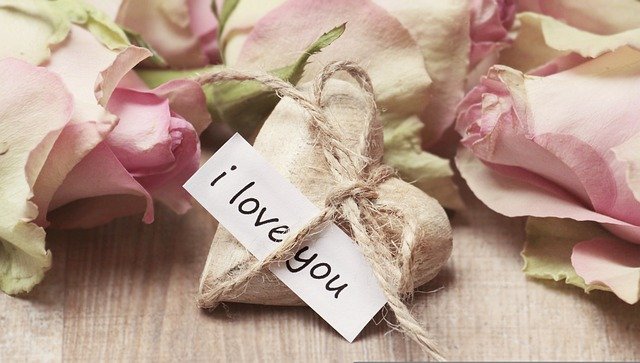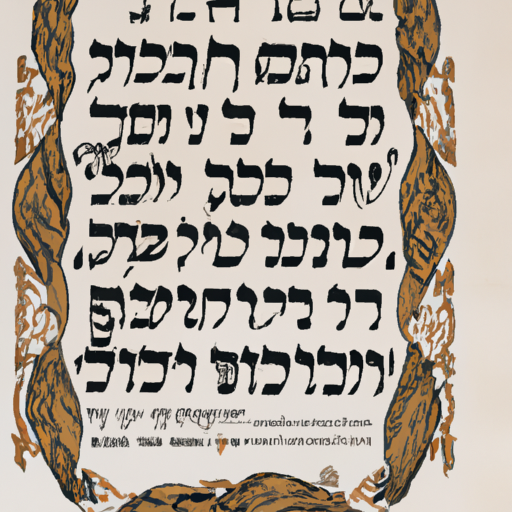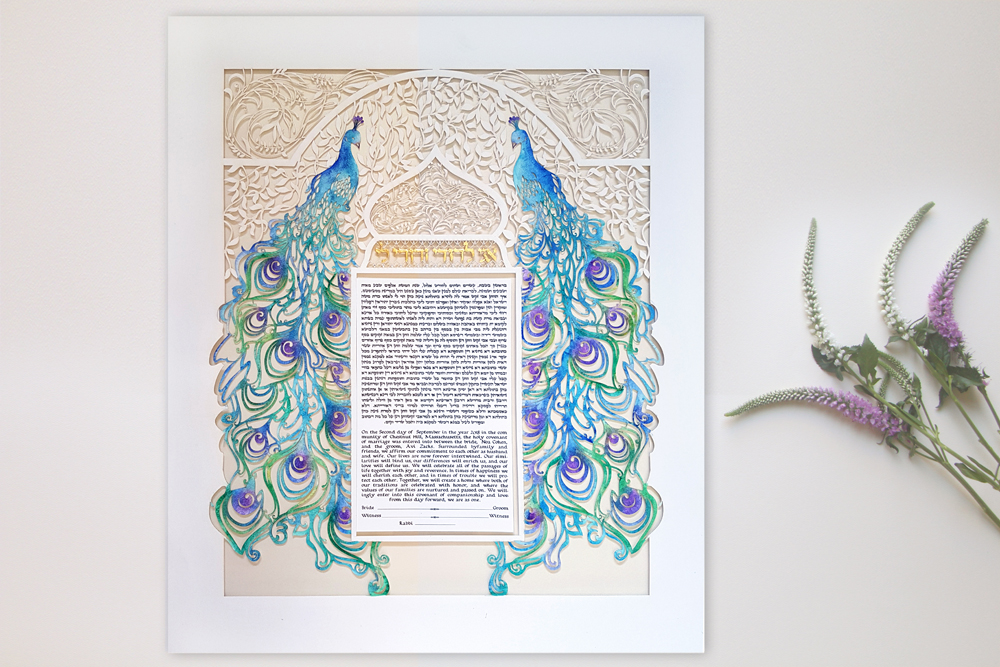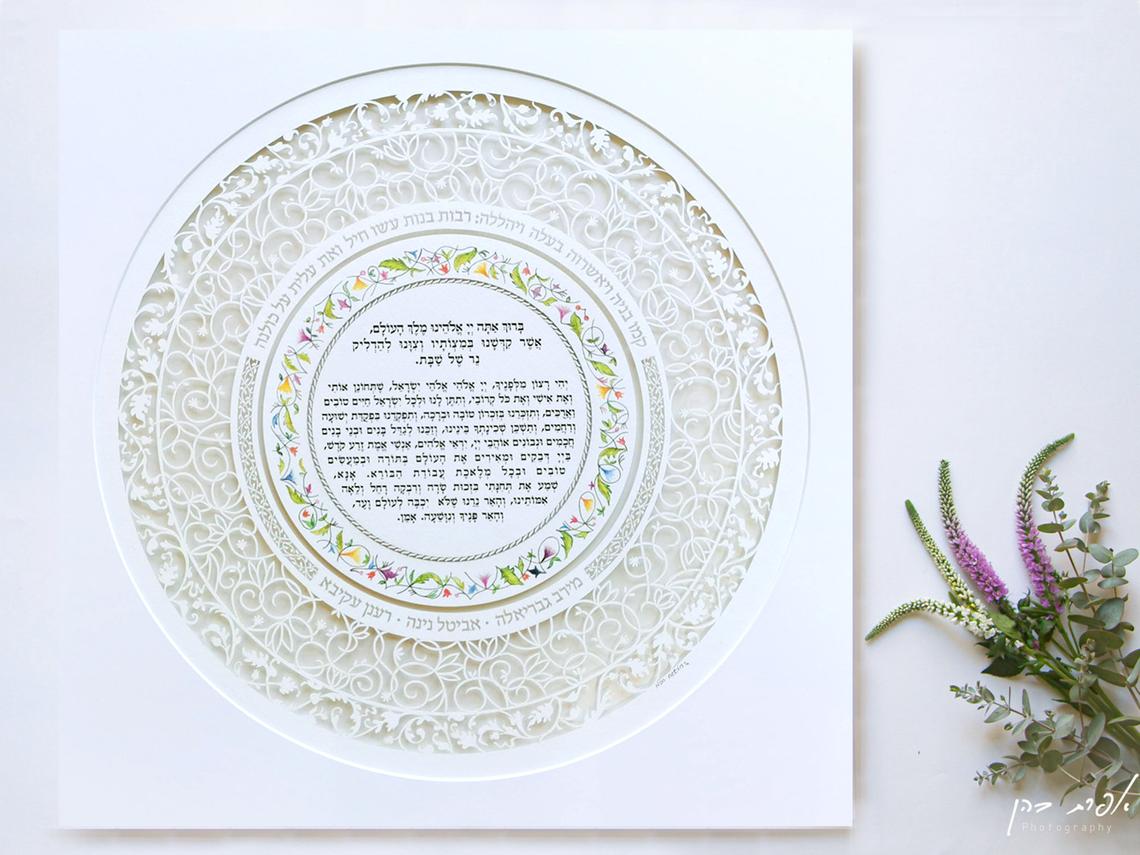
This blog post aims to dissect the richly layered symbolism present in Ketubah art, a traditional Jewish marriage contract. From the intricate design patterns to the narrative scenes, we explore how these elements serve not just as decor but as meaningful symbols reflecting Jewish culture, history, and values.
The Historical Significance of Ketubah Art
Ketubah art holds a rich historical significance that spans centuries. Originating in Jewish tradition, the ketubah is a marriage contract that outlines the rights and responsibilities of the husband towards his wife. The art accompanying the ketubah serves a dual purpose of both beautifying the document and symbolically representing the bond between the couple. The artistry found in ketubahs is a testament to the importance placed on the institution of marriage and the celebration of love within Jewish culture.
Throughout history, ketubah art has evolved, reflecting the cultural and artistic trends of different time periods. From intricate calligraphy to elaborate illustrations, each ketubah tells a unique story. The art often incorporates religious symbols and motifs, such as the Star of David, the Tree of Life, or the Ten Commandments, which not only honor Jewish heritage but also reinforce the sacredness of the marriage union.
The motifs and symbols found in ketubah art also serve as a visual representation of the couple’s values and aspirations. For example, the depiction of flourishing foliage symbolizes fertility, growth, and abundance, while the presence of doves represents peace, harmony, and love. These symbols not only add beauty to the ketubah but also convey deeper meanings that resonate with the couple and their community.
Furthermore, ketubah art allows for a deeper connection to Jewish history and traditions. By incorporating elements from ancient Jewish art, such as geometric patterns or narrative scenes from biblical stories, ketubahs serve as a link to the past and a reminder of the enduring values and beliefs that have shaped Jewish culture over time.

An ancient Ketubah showcasing traditional Hebrew calligraphy and floral border
What Does the Flourishing Foliage Symbolize?
Flourishing foliage is a common motif seen in ketubah art, and its symbolism holds deep significance. The lush leaves and vibrant plants represent fertility, growth, and abundance within the marriage. Just as plants grow and flourish, the couple’s love and relationship are expected to thrive and blossom over time. The presence of flourishing foliage signifies a fruitful union, with the potential for a life filled with joy, prosperity, and the nurturing of future generations. This symbol serves as a hopeful reminder that love, like nature, has the capacity to evolve, adapt, and flourish even in challenging circumstances. It encourages the couple to cultivate their relationship, providing nourishment and care to ensure its ongoing vitality. Moreover, the imagery of flourishing foliage reflects the natural cycles of life and the seasons. Just as plants go through periods of growth, dormancy, and rebirth, so do relationships. This symbolism acknowledges that there will be ups and downs in the journey of marriage, but with patience, resilience, and love, the couple can weather any storm and emerge stronger. The flourishing foliage also represents the interconnectedness of all living things. It reminds the couple of their bond not only with each other but also with the world around them. It encourages them to embrace their role in nurturing and sustaining their relationship, just as plants rely on the sun, soil, and water for their growth. The presence of flourishing foliage in ketubah art serves as a powerful visual reminder of the potential for growth, abundance, and everlasting love within the sacred bond of marriage.
“Love Birds” in Ketubah Art: What Do They Represent?
Birds are a recurring symbol in ketubah art, often depicted as a pair of love birds perched together. These love birds represent the deep bond and affection between the couple. They symbolize the unity and harmony that marriage brings, as well as the idea of companionship and partnership. Just as birds mate for life and rely on each other for support, the love birds in ketubah art signify the commitment and devotion that the couple has for one another. These birds also represent freedom and the soaring of spirits that comes with being in love. Their presence in the artwork serves as a reminder of the joy and happiness that love brings into our lives. The love birds are often depicted in a nest or surrounded by nature, emphasizing the connection between love, home, and the natural world. This symbolism reinforces the idea that love is a sanctuary, a place of comfort and security. The love birds in ketubah art also symbolize communication and the importance of open and honest dialogue within a relationship. Birds are known for their songs and their ability to communicate through their melodic chirping. Similarly, the presence of love birds in ketubah art reminds the couple of the significance of effective communication in their marriage. It serves as a reminder to always listen to one another, to express their feelings, and to maintain a strong emotional connection. The love birds in ketubah art represent the beauty and power of love, reminding the couple of the deep bond they share and inspiring them to nurture and cherish their relationship.

A Ketubah
The Role of Color Symbolism in Ketubah Design
Color plays a significant role in ketubah design, as it adds depth and meaning to the artwork. Different colors are chosen deliberately to evoke specific emotions and convey symbolic messages.
- 1. Warm Colors:
Warm colors such as red, orange, and yellow are commonly used in ketubah art to represent passion, love, and warmth. These colors symbolize the intense emotions and fiery love that the couple shares. Red, in particular, is often associated with romance and desire, while orange signifies energy, enthusiasm, and creativity. Yellow represents joy, happiness, and optimism, reflecting the positive outlook that the couple has for their future together. - 2. Cool Colors:
Cool colors like blue and green are frequently used in ketubah art to create a sense of tranquility, peace, and harmony. Blue symbolizes loyalty, trust, and stability, reflecting the strong foundation of the couple’s relationship. Green represents growth, renewal, and fertility, signifying the continuous development and nurturing of their love. - 3. Gold and Silver:
Metallic colors such as gold and silver are often incorporated into ketubah designs to add a touch of elegance and luxury. Gold symbolizes prosperity, abundance, and divine blessings, signifying the couple’s hopes for a prosperous and fulfilling life together. Silver represents purity, grace, and wisdom, reflecting the couple’s commitment to honor and cherish one another.
How Does Geometric Patterns Reflect Jewish Beliefs?
Geometric patterns are a common feature in ketubah art and hold significant meaning in Jewish beliefs. These intricate designs go beyond aesthetic appeal and serve as a representation of various aspects of Jewish culture and spirituality.
- 1. Sacred Geometry:
The use of geometric patterns in ketubah art reflects the concept of sacred geometry in Jewish beliefs. Sacred geometry is the belief that certain geometric shapes and patterns hold divine significance. In ketubah design, patterns such as the Star of David, the Tree of Life, and the Flower of Life are often incorporated. These sacred symbols represent the interconnectedness of all things and the divine order of the universe. - 2. Balance and Harmony:
Geometric patterns in ketubah art also symbolize the importance of balance and harmony in Jewish beliefs. The precise symmetry and repetition of geometric shapes convey a sense of order and equilibrium. This reflects the Jewish value of maintaining balance in all aspects of life, including relationships, spirituality, and community. The geometric patterns remind the couple of the need to strive for harmony and equilibrium in their marriage. - 3. Continuity and Permanence:
Geometric patterns in ketubah art often feature infinite loops, interlocking shapes, and intricate latticework. These designs symbolize the concept of continuity and permanence in Jewish beliefs. They represent the eternal nature of the couple’s commitment to one another and their connection to the Jewish faith. The geometric patterns serve as a reminder that marriage is a lifelong journey, and the love and bond between the couple should endure through all the ups and downs of life.

A geometrically patterned Ketubah drawing inspiration
Interpreting Narrative Scenes in Ketubah Art: A Deeper Look
Ketubah art often features narrative scenes that tell a story or depict significant moments in Jewish history and tradition. These scenes go beyond mere decoration and hold deeper symbolism, offering a glimpse into the rich cultural heritage of the Jewish people.
One common narrative scene found in ketubah art is the depiction of the exodus from Egypt. This scene represents the liberation of the Jewish people from slavery and their journey towards freedom. It serves as a reminder of the importance of freedom, resilience, and the pursuit of justice. The presence of this narrative scene in a ketubah reinforces the couple’s commitment to upholding these values in their own lives and relationship.
Another frequently depicted narrative scene is the wedding at Mount Sinai. This scene represents the covenant between God and the Jewish people, symbolizing the sacred bond of marriage. The imagery of this scene emphasizes the spiritual aspect of marriage and highlights the couple’s commitment to live their lives in accordance with Jewish traditions and values.
In addition to these historical narratives, ketubah art may also include scenes that represent Jewish festivals, rituals, or biblical stories. These scenes provide a visual connection to Jewish customs and traditions, reminding the couple of their commitment to uphold these practices in their own lives and pass them on to future generations.
Why is the Hamsa Hand Frequently Featured?
The Hamsa hand, also known as the Hand of Fatima or Hand of Miriam, is a popular symbol in Jewish and Middle Eastern cultures. It is frequently featured in ketubah art due to its deep-rooted symbolism and protective qualities. The Hamsa hand is believed to ward off evil and bring blessings, making it a fitting symbol to include in a ketubah, which represents the couple’s commitment to a harmonious and blessed marriage.
The Hamsa hand is shaped like an open hand with an eye in the center, representing the all-seeing eye of God. This symbolizes divine protection and guidance, serving as a reminder for the couple to seek and rely on God’s presence in their relationship. By including the Hamsa hand in their ketubah, couples are expressing their desire for spiritual protection and blessings as they embark on their journey together.
Furthermore, the Hamsa hand is also associated with good fortune, luck, and prosperity. It is believed to bring positive energy and ward off negative influences. By featuring the Hamsa hand in their ketubah, couples are symbolically inviting good fortune and positive energy into their marriage, creating a foundation of abundance and prosperity.
The Hamsa hand’s frequent inclusion in ketubah art also reflects the importance of cultural and ancestral connections. Many Jewish couples value their heritage and traditions and wish to incorporate them into their marriage ceremony. By featuring the Hamsa hand, they are honoring their roots and embracing the cultural significance of this symbol in Jewish and Middle Eastern communities.

A among other symbols
In conclusion, the artistry in Ketubah is far more than meets the eye. It’s a tale of love, commitment, and Jewish heritage, interwoven with intricate symbolism. Understanding its symbolism gives us a deeper appreciation of its beauty and the profound messages it carries.
https://noaattias.com/
Recent Comments